The Impact of Website Quality on E-Satisfaction and E-Loyalty: Zalora
VerifiedAdded on 2020/04/15
|13
|2088
|508
Report
AI Summary
This research proposal investigates the effects of website quality, e-satisfaction, and e-loyalty within the context of Zalora's online store, focusing on sports apparel consumers. The study aims to establish the relationships between these factors, formulating hypotheses to analyze how website quality influences both e-satisfaction and e-loyalty. The methodology includes primary research using questionnaires, the Sports Website Quality Scale (SWQS), and stratified sampling of university students who are also sports enthusiasts, alongside secondary research to gather supporting evidence. The proposal outlines a work schedule and references relevant literature to support its objectives, aiming to provide recommendations for fashion online stores to enhance e-satisfaction and e-loyalty through superior website quality.
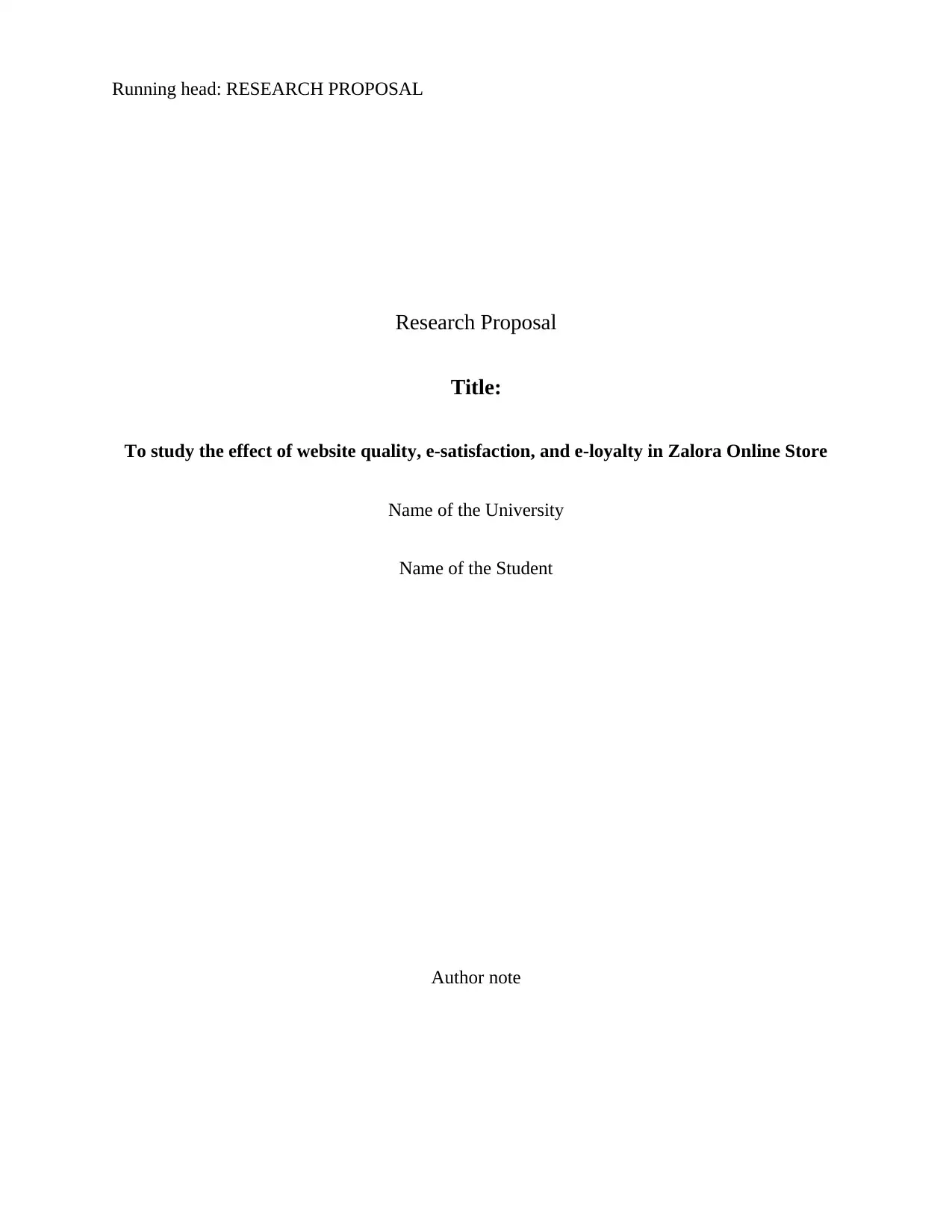
Running head: RESEARCH PROPOSAL
Research Proposal
Title:
To study the effect of website quality, e-satisfaction, and e-loyalty in Zalora Online Store
Name of the University
Name of the Student
Author note
Research Proposal
Title:
To study the effect of website quality, e-satisfaction, and e-loyalty in Zalora Online Store
Name of the University
Name of the Student
Author note
Paraphrase This Document
Need a fresh take? Get an instant paraphrase of this document with our AI Paraphraser
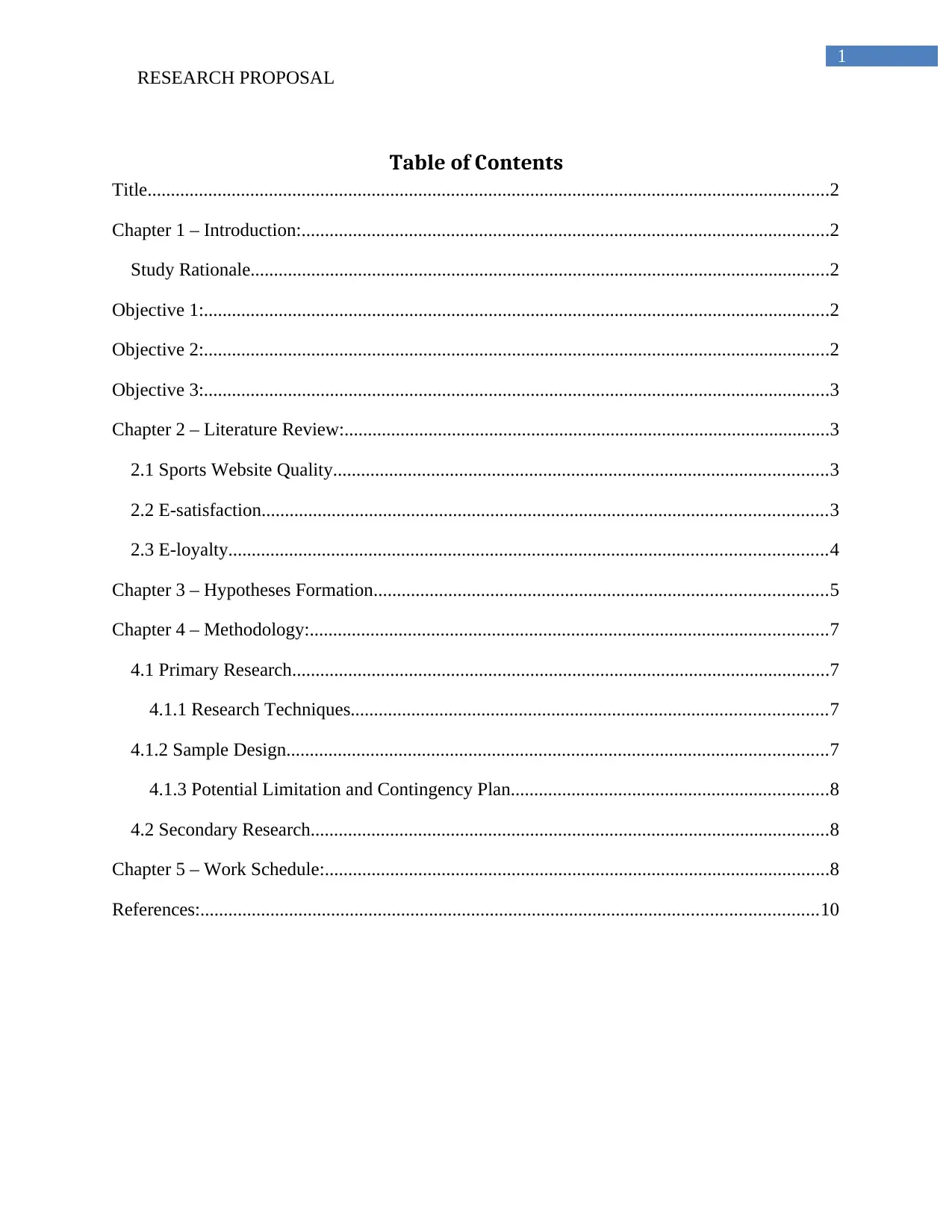
1
RESEARCH PROPOSAL
Table of Contents
Title..................................................................................................................................................2
Chapter 1 – Introduction:.................................................................................................................2
Study Rationale............................................................................................................................2
Objective 1:......................................................................................................................................2
Objective 2:......................................................................................................................................2
Objective 3:......................................................................................................................................3
Chapter 2 – Literature Review:........................................................................................................3
2.1 Sports Website Quality..........................................................................................................3
2.2 E-satisfaction.........................................................................................................................3
2.3 E-loyalty................................................................................................................................4
Chapter 3 – Hypotheses Formation.................................................................................................5
Chapter 4 – Methodology:...............................................................................................................7
4.1 Primary Research...................................................................................................................7
4.1.1 Research Techniques......................................................................................................7
4.1.2 Sample Design....................................................................................................................7
4.1.3 Potential Limitation and Contingency Plan....................................................................8
4.2 Secondary Research...............................................................................................................8
Chapter 5 – Work Schedule:............................................................................................................8
References:....................................................................................................................................10
RESEARCH PROPOSAL
Table of Contents
Title..................................................................................................................................................2
Chapter 1 – Introduction:.................................................................................................................2
Study Rationale............................................................................................................................2
Objective 1:......................................................................................................................................2
Objective 2:......................................................................................................................................2
Objective 3:......................................................................................................................................3
Chapter 2 – Literature Review:........................................................................................................3
2.1 Sports Website Quality..........................................................................................................3
2.2 E-satisfaction.........................................................................................................................3
2.3 E-loyalty................................................................................................................................4
Chapter 3 – Hypotheses Formation.................................................................................................5
Chapter 4 – Methodology:...............................................................................................................7
4.1 Primary Research...................................................................................................................7
4.1.1 Research Techniques......................................................................................................7
4.1.2 Sample Design....................................................................................................................7
4.1.3 Potential Limitation and Contingency Plan....................................................................8
4.2 Secondary Research...............................................................................................................8
Chapter 5 – Work Schedule:............................................................................................................8
References:....................................................................................................................................10
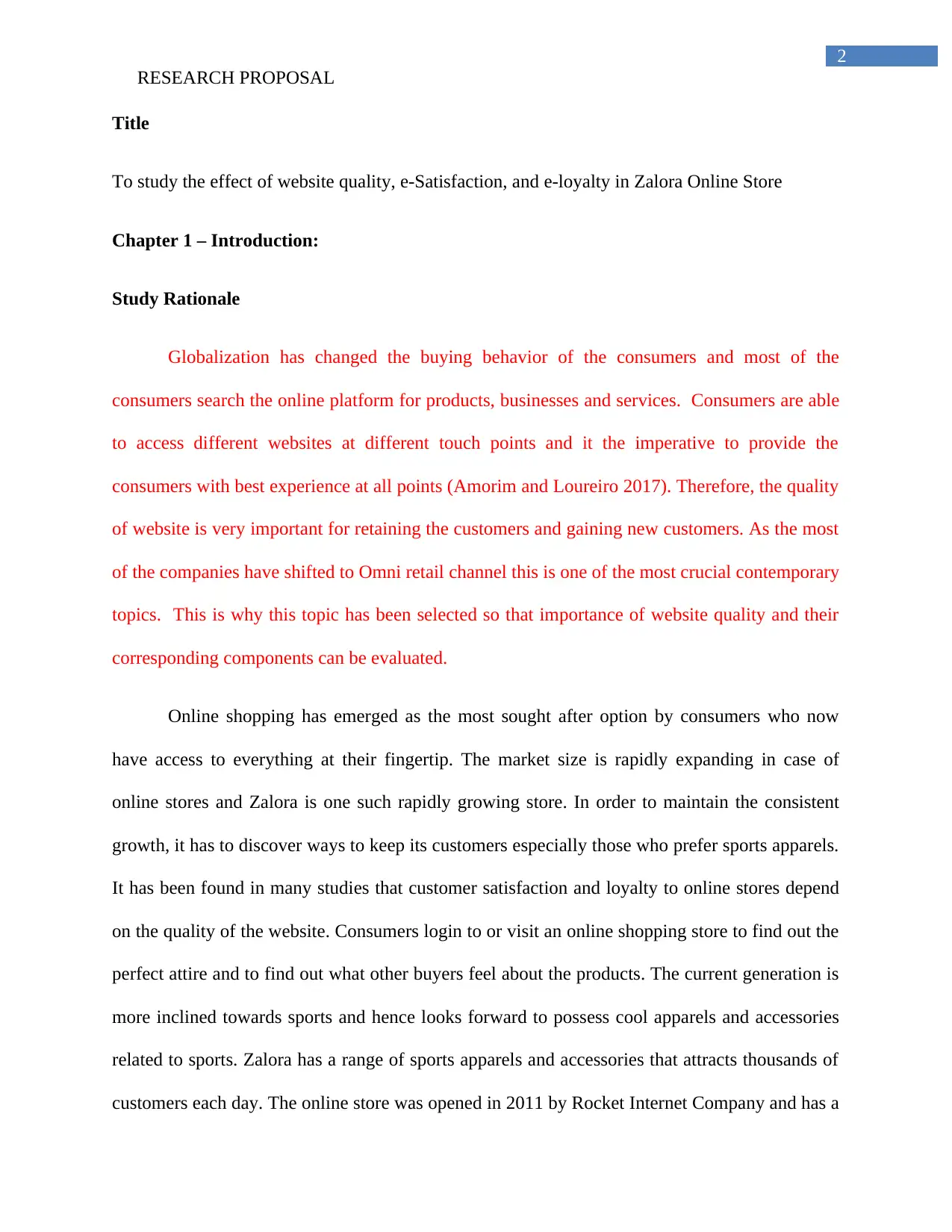
2
RESEARCH PROPOSAL
Title
To study the effect of website quality, e-Satisfaction, and e-loyalty in Zalora Online Store
Chapter 1 – Introduction:
Study Rationale
Globalization has changed the buying behavior of the consumers and most of the
consumers search the online platform for products, businesses and services. Consumers are able
to access different websites at different touch points and it the imperative to provide the
consumers with best experience at all points (Amorim and Loureiro 2017). Therefore, the quality
of website is very important for retaining the customers and gaining new customers. As the most
of the companies have shifted to Omni retail channel this is one of the most crucial contemporary
topics. This is why this topic has been selected so that importance of website quality and their
corresponding components can be evaluated.
Online shopping has emerged as the most sought after option by consumers who now
have access to everything at their fingertip. The market size is rapidly expanding in case of
online stores and Zalora is one such rapidly growing store. In order to maintain the consistent
growth, it has to discover ways to keep its customers especially those who prefer sports apparels.
It has been found in many studies that customer satisfaction and loyalty to online stores depend
on the quality of the website. Consumers login to or visit an online shopping store to find out the
perfect attire and to find out what other buyers feel about the products. The current generation is
more inclined towards sports and hence looks forward to possess cool apparels and accessories
related to sports. Zalora has a range of sports apparels and accessories that attracts thousands of
customers each day. The online store was opened in 2011 by Rocket Internet Company and has a
RESEARCH PROPOSAL
Title
To study the effect of website quality, e-Satisfaction, and e-loyalty in Zalora Online Store
Chapter 1 – Introduction:
Study Rationale
Globalization has changed the buying behavior of the consumers and most of the
consumers search the online platform for products, businesses and services. Consumers are able
to access different websites at different touch points and it the imperative to provide the
consumers with best experience at all points (Amorim and Loureiro 2017). Therefore, the quality
of website is very important for retaining the customers and gaining new customers. As the most
of the companies have shifted to Omni retail channel this is one of the most crucial contemporary
topics. This is why this topic has been selected so that importance of website quality and their
corresponding components can be evaluated.
Online shopping has emerged as the most sought after option by consumers who now
have access to everything at their fingertip. The market size is rapidly expanding in case of
online stores and Zalora is one such rapidly growing store. In order to maintain the consistent
growth, it has to discover ways to keep its customers especially those who prefer sports apparels.
It has been found in many studies that customer satisfaction and loyalty to online stores depend
on the quality of the website. Consumers login to or visit an online shopping store to find out the
perfect attire and to find out what other buyers feel about the products. The current generation is
more inclined towards sports and hence looks forward to possess cool apparels and accessories
related to sports. Zalora has a range of sports apparels and accessories that attracts thousands of
customers each day. The online store was opened in 2011 by Rocket Internet Company and has a
⊘ This is a preview!⊘
Do you want full access?
Subscribe today to unlock all pages.

Trusted by 1+ million students worldwide
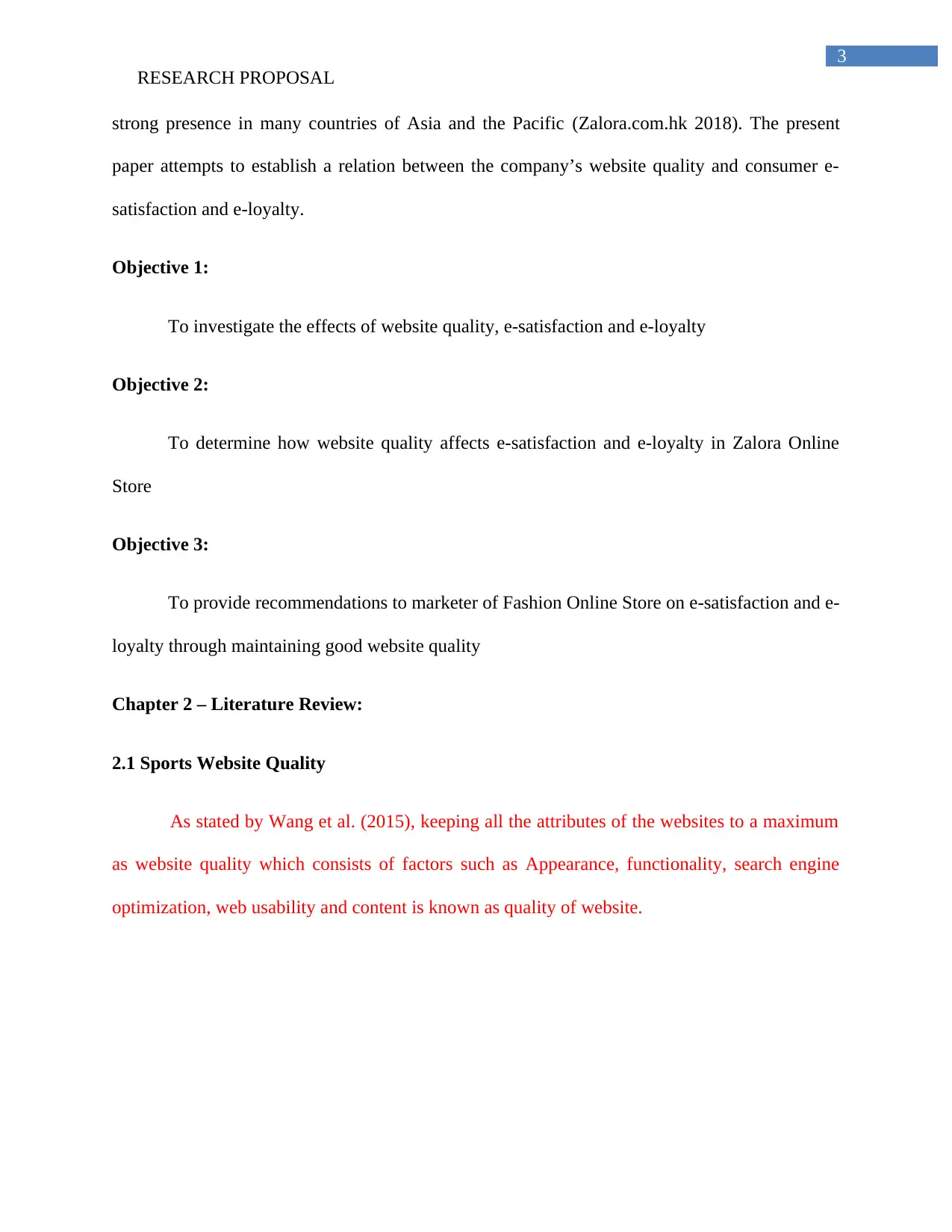
3
RESEARCH PROPOSAL
strong presence in many countries of Asia and the Pacific (Zalora.com.hk 2018). The present
paper attempts to establish a relation between the company’s website quality and consumer e-
satisfaction and e-loyalty.
Objective 1:
To investigate the effects of website quality, e-satisfaction and e-loyalty
Objective 2:
To determine how website quality affects e-satisfaction and e-loyalty in Zalora Online
Store
Objective 3:
To provide recommendations to marketer of Fashion Online Store on e-satisfaction and e-
loyalty through maintaining good website quality
Chapter 2 – Literature Review:
2.1 Sports Website Quality
As stated by Wang et al. (2015), keeping all the attributes of the websites to a maximum
as website quality which consists of factors such as Appearance, functionality, search engine
optimization, web usability and content is known as quality of website.
RESEARCH PROPOSAL
strong presence in many countries of Asia and the Pacific (Zalora.com.hk 2018). The present
paper attempts to establish a relation between the company’s website quality and consumer e-
satisfaction and e-loyalty.
Objective 1:
To investigate the effects of website quality, e-satisfaction and e-loyalty
Objective 2:
To determine how website quality affects e-satisfaction and e-loyalty in Zalora Online
Store
Objective 3:
To provide recommendations to marketer of Fashion Online Store on e-satisfaction and e-
loyalty through maintaining good website quality
Chapter 2 – Literature Review:
2.1 Sports Website Quality
As stated by Wang et al. (2015), keeping all the attributes of the websites to a maximum
as website quality which consists of factors such as Appearance, functionality, search engine
optimization, web usability and content is known as quality of website.
Paraphrase This Document
Need a fresh take? Get an instant paraphrase of this document with our AI Paraphraser
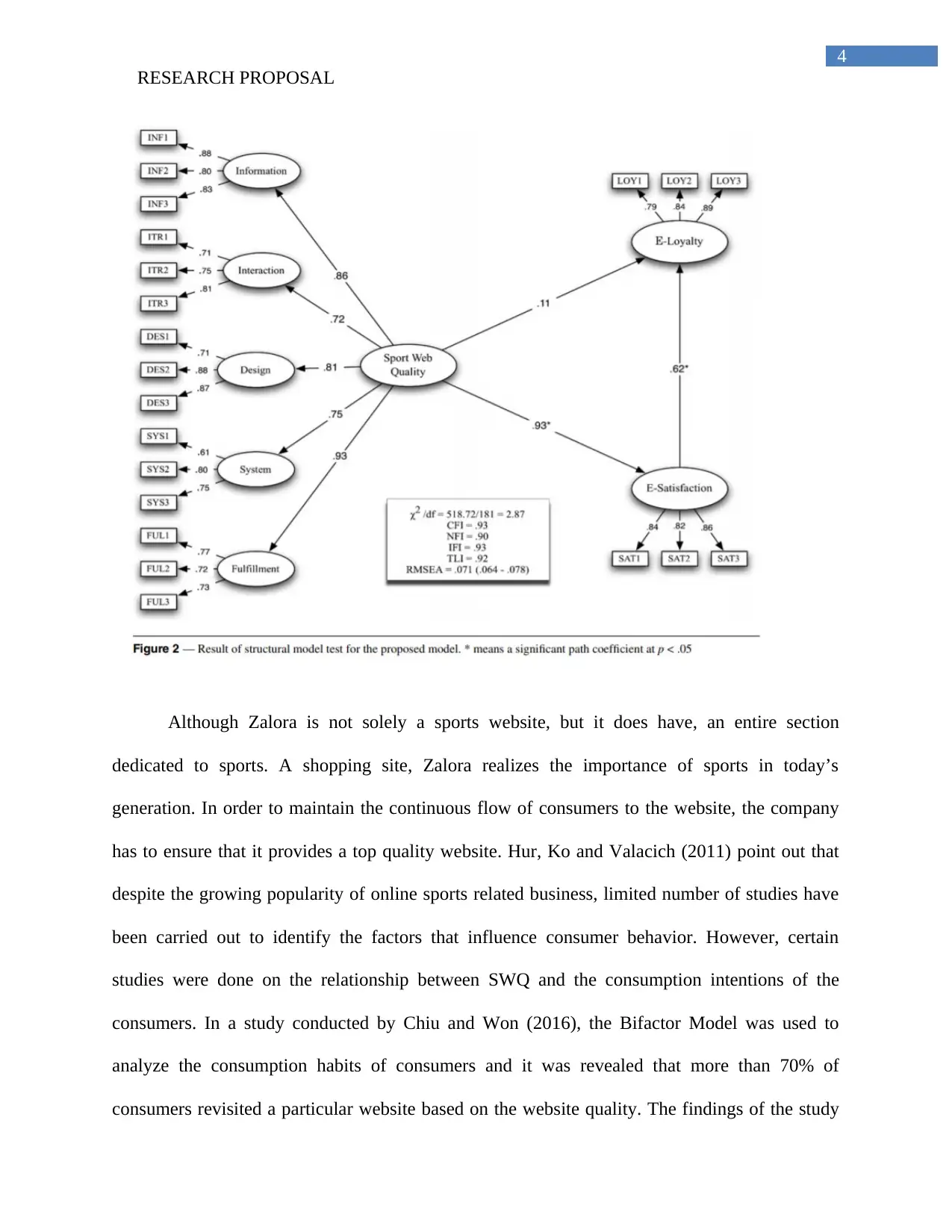
4
RESEARCH PROPOSAL
Although Zalora is not solely a sports website, but it does have, an entire section
dedicated to sports. A shopping site, Zalora realizes the importance of sports in today’s
generation. In order to maintain the continuous flow of consumers to the website, the company
has to ensure that it provides a top quality website. Hur, Ko and Valacich (2011) point out that
despite the growing popularity of online sports related business, limited number of studies have
been carried out to identify the factors that influence consumer behavior. However, certain
studies were done on the relationship between SWQ and the consumption intentions of the
consumers. In a study conducted by Chiu and Won (2016), the Bifactor Model was used to
analyze the consumption habits of consumers and it was revealed that more than 70% of
consumers revisited a particular website based on the website quality. The findings of the study
RESEARCH PROPOSAL
Although Zalora is not solely a sports website, but it does have, an entire section
dedicated to sports. A shopping site, Zalora realizes the importance of sports in today’s
generation. In order to maintain the continuous flow of consumers to the website, the company
has to ensure that it provides a top quality website. Hur, Ko and Valacich (2011) point out that
despite the growing popularity of online sports related business, limited number of studies have
been carried out to identify the factors that influence consumer behavior. However, certain
studies were done on the relationship between SWQ and the consumption intentions of the
consumers. In a study conducted by Chiu and Won (2016), the Bifactor Model was used to
analyze the consumption habits of consumers and it was revealed that more than 70% of
consumers revisited a particular website based on the website quality. The findings of the study
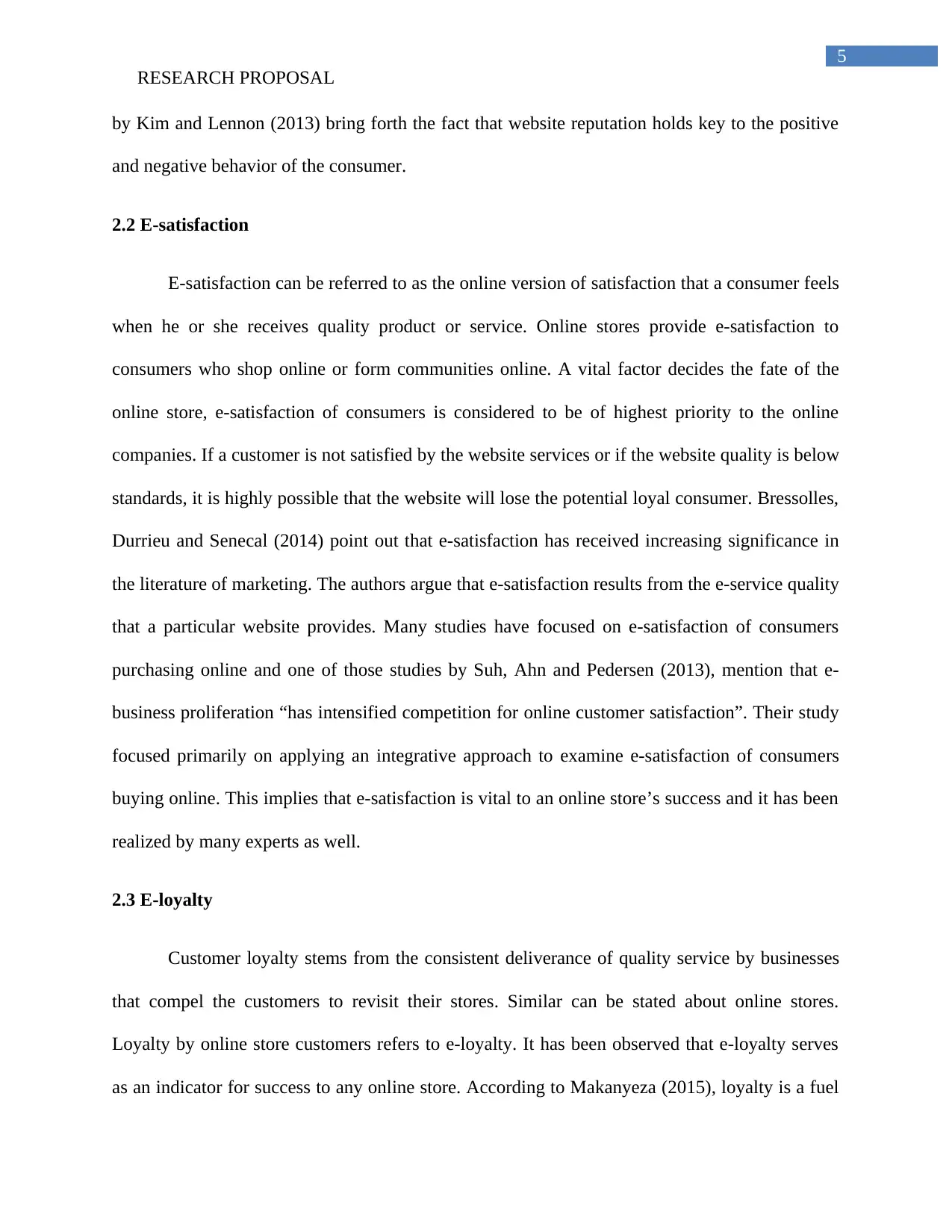
5
RESEARCH PROPOSAL
by Kim and Lennon (2013) bring forth the fact that website reputation holds key to the positive
and negative behavior of the consumer.
2.2 E-satisfaction
E-satisfaction can be referred to as the online version of satisfaction that a consumer feels
when he or she receives quality product or service. Online stores provide e-satisfaction to
consumers who shop online or form communities online. A vital factor decides the fate of the
online store, e-satisfaction of consumers is considered to be of highest priority to the online
companies. If a customer is not satisfied by the website services or if the website quality is below
standards, it is highly possible that the website will lose the potential loyal consumer. Bressolles,
Durrieu and Senecal (2014) point out that e-satisfaction has received increasing significance in
the literature of marketing. The authors argue that e-satisfaction results from the e-service quality
that a particular website provides. Many studies have focused on e-satisfaction of consumers
purchasing online and one of those studies by Suh, Ahn and Pedersen (2013), mention that e-
business proliferation “has intensified competition for online customer satisfaction”. Their study
focused primarily on applying an integrative approach to examine e-satisfaction of consumers
buying online. This implies that e-satisfaction is vital to an online store’s success and it has been
realized by many experts as well.
2.3 E-loyalty
Customer loyalty stems from the consistent deliverance of quality service by businesses
that compel the customers to revisit their stores. Similar can be stated about online stores.
Loyalty by online store customers refers to e-loyalty. It has been observed that e-loyalty serves
as an indicator for success to any online store. According to Makanyeza (2015), loyalty is a fuel
RESEARCH PROPOSAL
by Kim and Lennon (2013) bring forth the fact that website reputation holds key to the positive
and negative behavior of the consumer.
2.2 E-satisfaction
E-satisfaction can be referred to as the online version of satisfaction that a consumer feels
when he or she receives quality product or service. Online stores provide e-satisfaction to
consumers who shop online or form communities online. A vital factor decides the fate of the
online store, e-satisfaction of consumers is considered to be of highest priority to the online
companies. If a customer is not satisfied by the website services or if the website quality is below
standards, it is highly possible that the website will lose the potential loyal consumer. Bressolles,
Durrieu and Senecal (2014) point out that e-satisfaction has received increasing significance in
the literature of marketing. The authors argue that e-satisfaction results from the e-service quality
that a particular website provides. Many studies have focused on e-satisfaction of consumers
purchasing online and one of those studies by Suh, Ahn and Pedersen (2013), mention that e-
business proliferation “has intensified competition for online customer satisfaction”. Their study
focused primarily on applying an integrative approach to examine e-satisfaction of consumers
buying online. This implies that e-satisfaction is vital to an online store’s success and it has been
realized by many experts as well.
2.3 E-loyalty
Customer loyalty stems from the consistent deliverance of quality service by businesses
that compel the customers to revisit their stores. Similar can be stated about online stores.
Loyalty by online store customers refers to e-loyalty. It has been observed that e-loyalty serves
as an indicator for success to any online store. According to Makanyeza (2015), loyalty is a fuel
⊘ This is a preview!⊘
Do you want full access?
Subscribe today to unlock all pages.

Trusted by 1+ million students worldwide
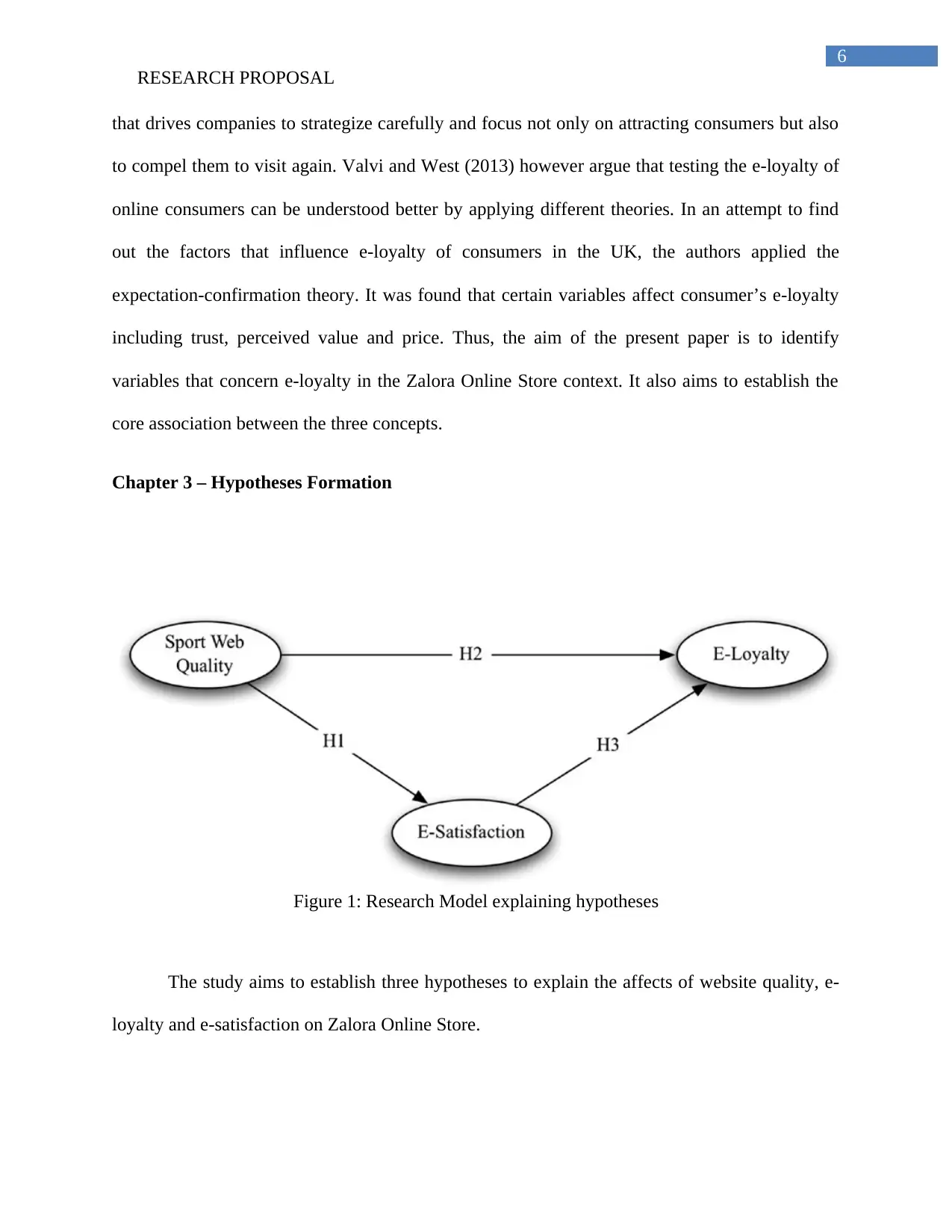
6
RESEARCH PROPOSAL
that drives companies to strategize carefully and focus not only on attracting consumers but also
to compel them to visit again. Valvi and West (2013) however argue that testing the e-loyalty of
online consumers can be understood better by applying different theories. In an attempt to find
out the factors that influence e-loyalty of consumers in the UK, the authors applied the
expectation-confirmation theory. It was found that certain variables affect consumer’s e-loyalty
including trust, perceived value and price. Thus, the aim of the present paper is to identify
variables that concern e-loyalty in the Zalora Online Store context. It also aims to establish the
core association between the three concepts.
Chapter 3 – Hypotheses Formation
Figure 1: Research Model explaining hypotheses
The study aims to establish three hypotheses to explain the affects of website quality, e-
loyalty and e-satisfaction on Zalora Online Store.
RESEARCH PROPOSAL
that drives companies to strategize carefully and focus not only on attracting consumers but also
to compel them to visit again. Valvi and West (2013) however argue that testing the e-loyalty of
online consumers can be understood better by applying different theories. In an attempt to find
out the factors that influence e-loyalty of consumers in the UK, the authors applied the
expectation-confirmation theory. It was found that certain variables affect consumer’s e-loyalty
including trust, perceived value and price. Thus, the aim of the present paper is to identify
variables that concern e-loyalty in the Zalora Online Store context. It also aims to establish the
core association between the three concepts.
Chapter 3 – Hypotheses Formation
Figure 1: Research Model explaining hypotheses
The study aims to establish three hypotheses to explain the affects of website quality, e-
loyalty and e-satisfaction on Zalora Online Store.
Paraphrase This Document
Need a fresh take? Get an instant paraphrase of this document with our AI Paraphraser
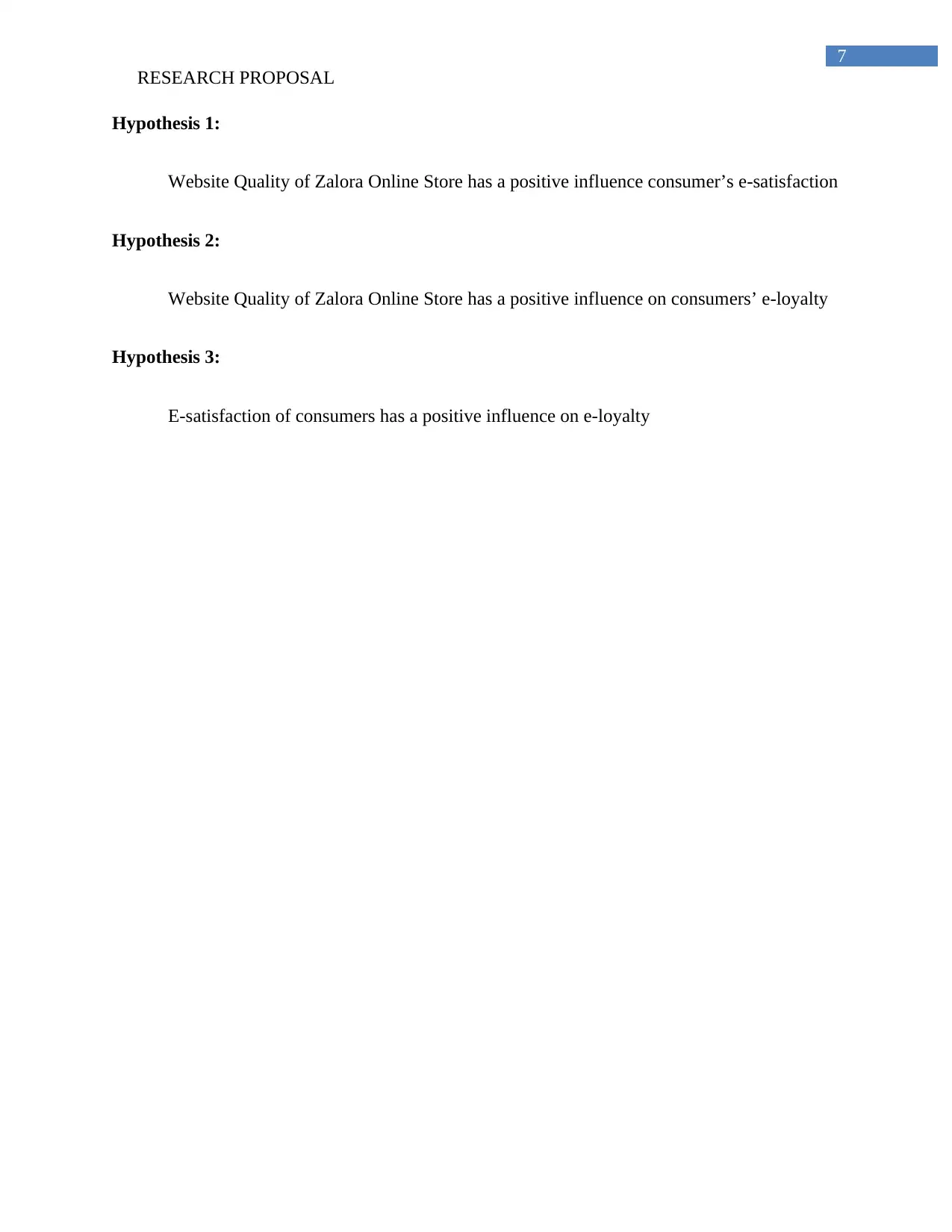
7
RESEARCH PROPOSAL
Hypothesis 1:
Website Quality of Zalora Online Store has a positive influence consumer’s e-satisfaction
Hypothesis 2:
Website Quality of Zalora Online Store has a positive influence on consumers’ e-loyalty
Hypothesis 3:
E-satisfaction of consumers has a positive influence on e-loyalty
RESEARCH PROPOSAL
Hypothesis 1:
Website Quality of Zalora Online Store has a positive influence consumer’s e-satisfaction
Hypothesis 2:
Website Quality of Zalora Online Store has a positive influence on consumers’ e-loyalty
Hypothesis 3:
E-satisfaction of consumers has a positive influence on e-loyalty
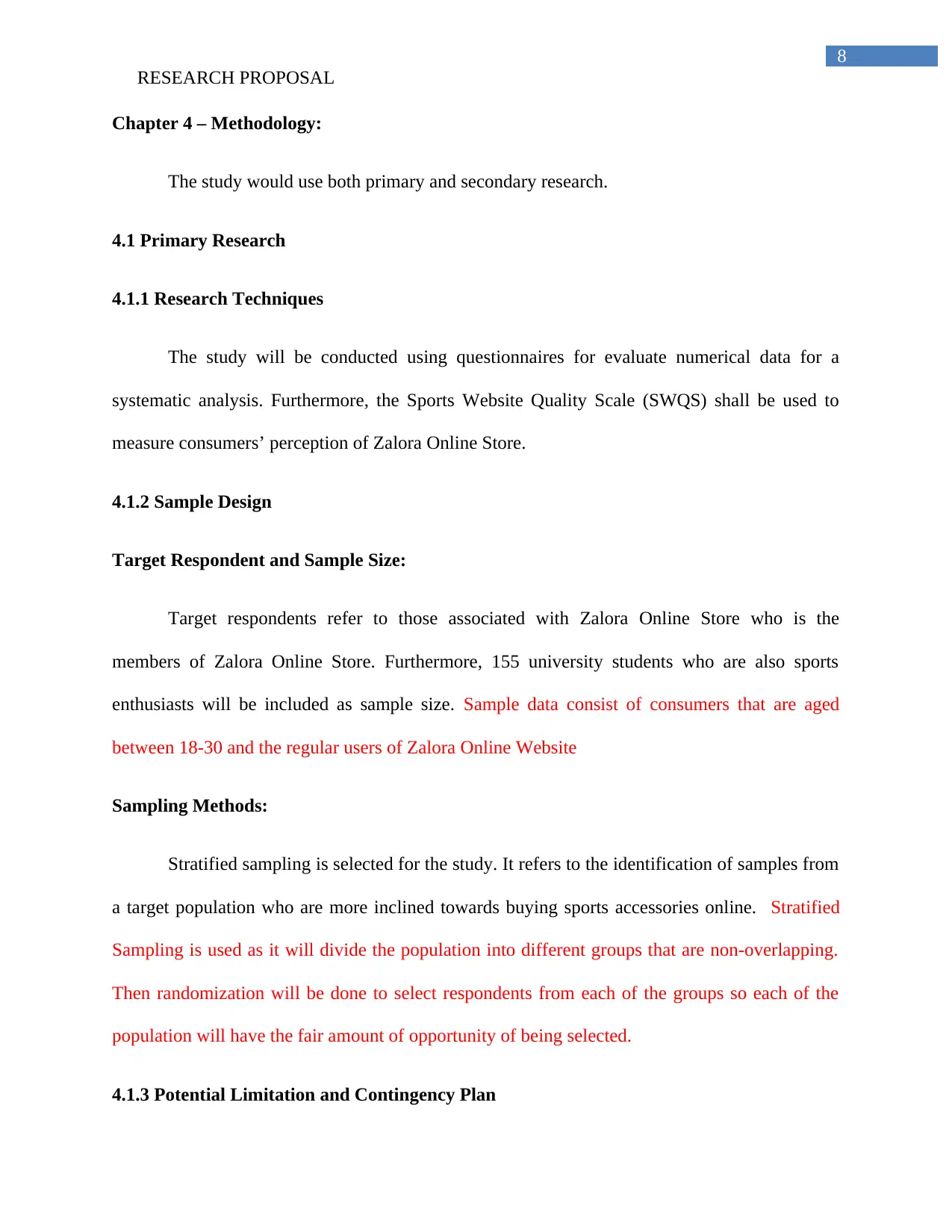
8
RESEARCH PROPOSAL
Chapter 4 – Methodology:
The study would use both primary and secondary research.
4.1 Primary Research
4.1.1 Research Techniques
The study will be conducted using questionnaires for evaluate numerical data for a
systematic analysis. Furthermore, the Sports Website Quality Scale (SWQS) shall be used to
measure consumers’ perception of Zalora Online Store.
4.1.2 Sample Design
Target Respondent and Sample Size:
Target respondents refer to those associated with Zalora Online Store who is the
members of Zalora Online Store. Furthermore, 155 university students who are also sports
enthusiasts will be included as sample size. Sample data consist of consumers that are aged
between 18-30 and the regular users of Zalora Online Website
Sampling Methods:
Stratified sampling is selected for the study. It refers to the identification of samples from
a target population who are more inclined towards buying sports accessories online. Stratified
Sampling is used as it will divide the population into different groups that are non-overlapping.
Then randomization will be done to select respondents from each of the groups so each of the
population will have the fair amount of opportunity of being selected.
4.1.3 Potential Limitation and Contingency Plan
RESEARCH PROPOSAL
Chapter 4 – Methodology:
The study would use both primary and secondary research.
4.1 Primary Research
4.1.1 Research Techniques
The study will be conducted using questionnaires for evaluate numerical data for a
systematic analysis. Furthermore, the Sports Website Quality Scale (SWQS) shall be used to
measure consumers’ perception of Zalora Online Store.
4.1.2 Sample Design
Target Respondent and Sample Size:
Target respondents refer to those associated with Zalora Online Store who is the
members of Zalora Online Store. Furthermore, 155 university students who are also sports
enthusiasts will be included as sample size. Sample data consist of consumers that are aged
between 18-30 and the regular users of Zalora Online Website
Sampling Methods:
Stratified sampling is selected for the study. It refers to the identification of samples from
a target population who are more inclined towards buying sports accessories online. Stratified
Sampling is used as it will divide the population into different groups that are non-overlapping.
Then randomization will be done to select respondents from each of the groups so each of the
population will have the fair amount of opportunity of being selected.
4.1.3 Potential Limitation and Contingency Plan
⊘ This is a preview!⊘
Do you want full access?
Subscribe today to unlock all pages.

Trusted by 1+ million students worldwide
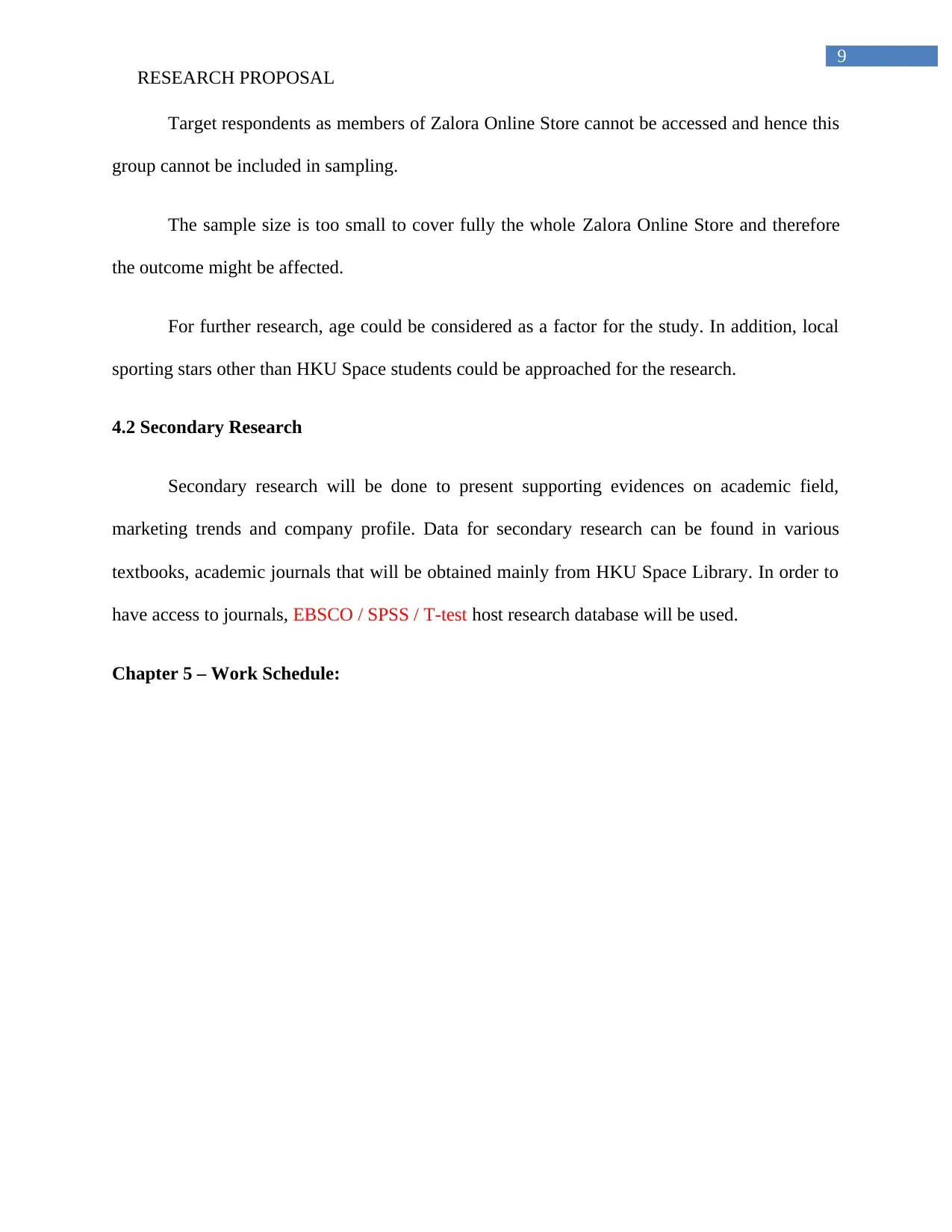
9
RESEARCH PROPOSAL
Target respondents as members of Zalora Online Store cannot be accessed and hence this
group cannot be included in sampling.
The sample size is too small to cover fully the whole Zalora Online Store and therefore
the outcome might be affected.
For further research, age could be considered as a factor for the study. In addition, local
sporting stars other than HKU Space students could be approached for the research.
4.2 Secondary Research
Secondary research will be done to present supporting evidences on academic field,
marketing trends and company profile. Data for secondary research can be found in various
textbooks, academic journals that will be obtained mainly from HKU Space Library. In order to
have access to journals, EBSCO / SPSS / T-test host research database will be used.
Chapter 5 – Work Schedule:
RESEARCH PROPOSAL
Target respondents as members of Zalora Online Store cannot be accessed and hence this
group cannot be included in sampling.
The sample size is too small to cover fully the whole Zalora Online Store and therefore
the outcome might be affected.
For further research, age could be considered as a factor for the study. In addition, local
sporting stars other than HKU Space students could be approached for the research.
4.2 Secondary Research
Secondary research will be done to present supporting evidences on academic field,
marketing trends and company profile. Data for secondary research can be found in various
textbooks, academic journals that will be obtained mainly from HKU Space Library. In order to
have access to journals, EBSCO / SPSS / T-test host research database will be used.
Chapter 5 – Work Schedule:
Paraphrase This Document
Need a fresh take? Get an instant paraphrase of this document with our AI Paraphraser
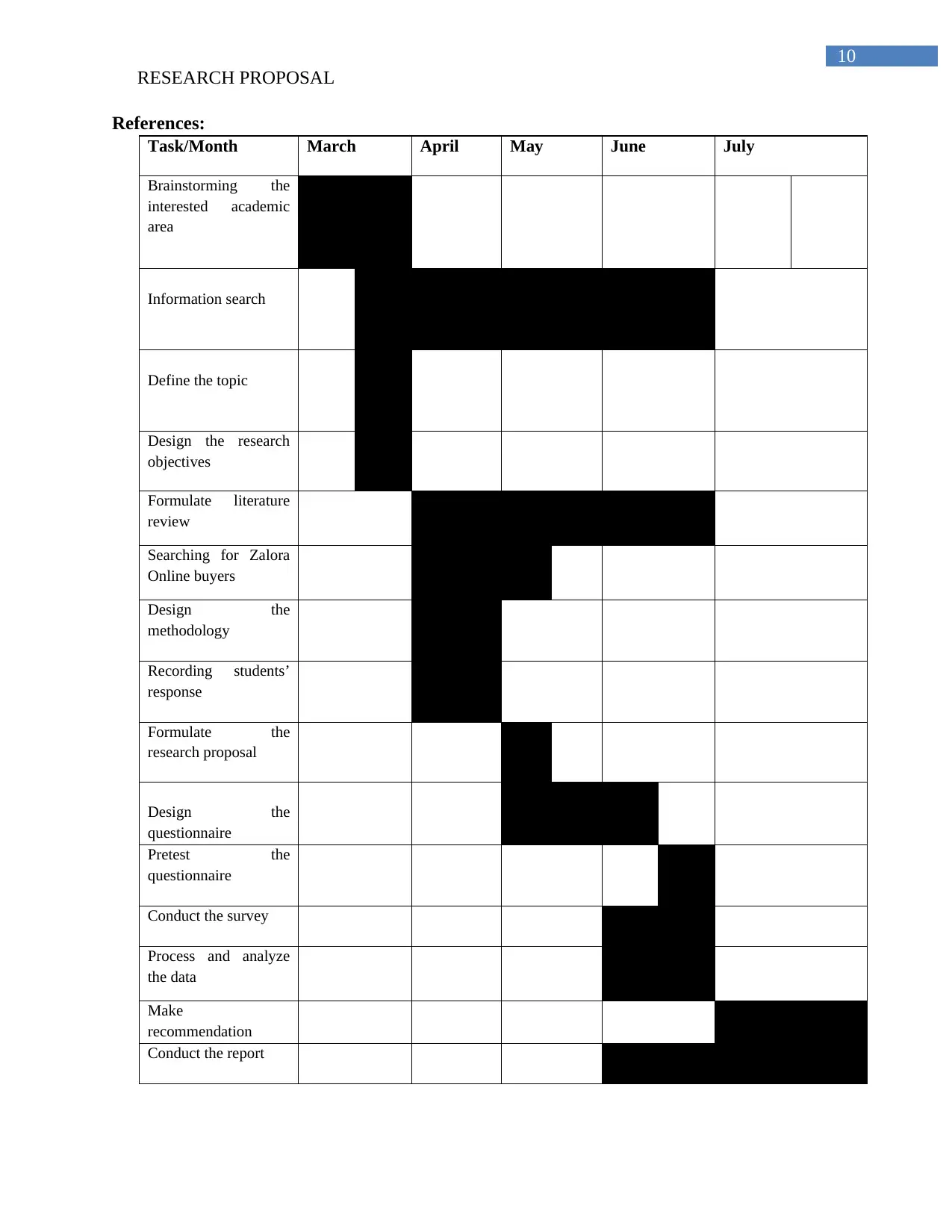
10
RESEARCH PROPOSAL
References:
Task/Month March April May June July
Brainstorming the
interested academic
area
Information search
Define the topic
Design the research
objectives
Formulate literature
review
Searching for Zalora
Online buyers
Design the
methodology
Recording students’
response
Formulate the
research proposal
Design the
questionnaire
Pretest the
questionnaire
Conduct the survey
Process and analyze
the data
Make
recommendation
Conduct the report
RESEARCH PROPOSAL
References:
Task/Month March April May June July
Brainstorming the
interested academic
area
Information search
Define the topic
Design the research
objectives
Formulate literature
review
Searching for Zalora
Online buyers
Design the
methodology
Recording students’
response
Formulate the
research proposal
Design the
questionnaire
Pretest the
questionnaire
Conduct the survey
Process and analyze
the data
Make
recommendation
Conduct the report
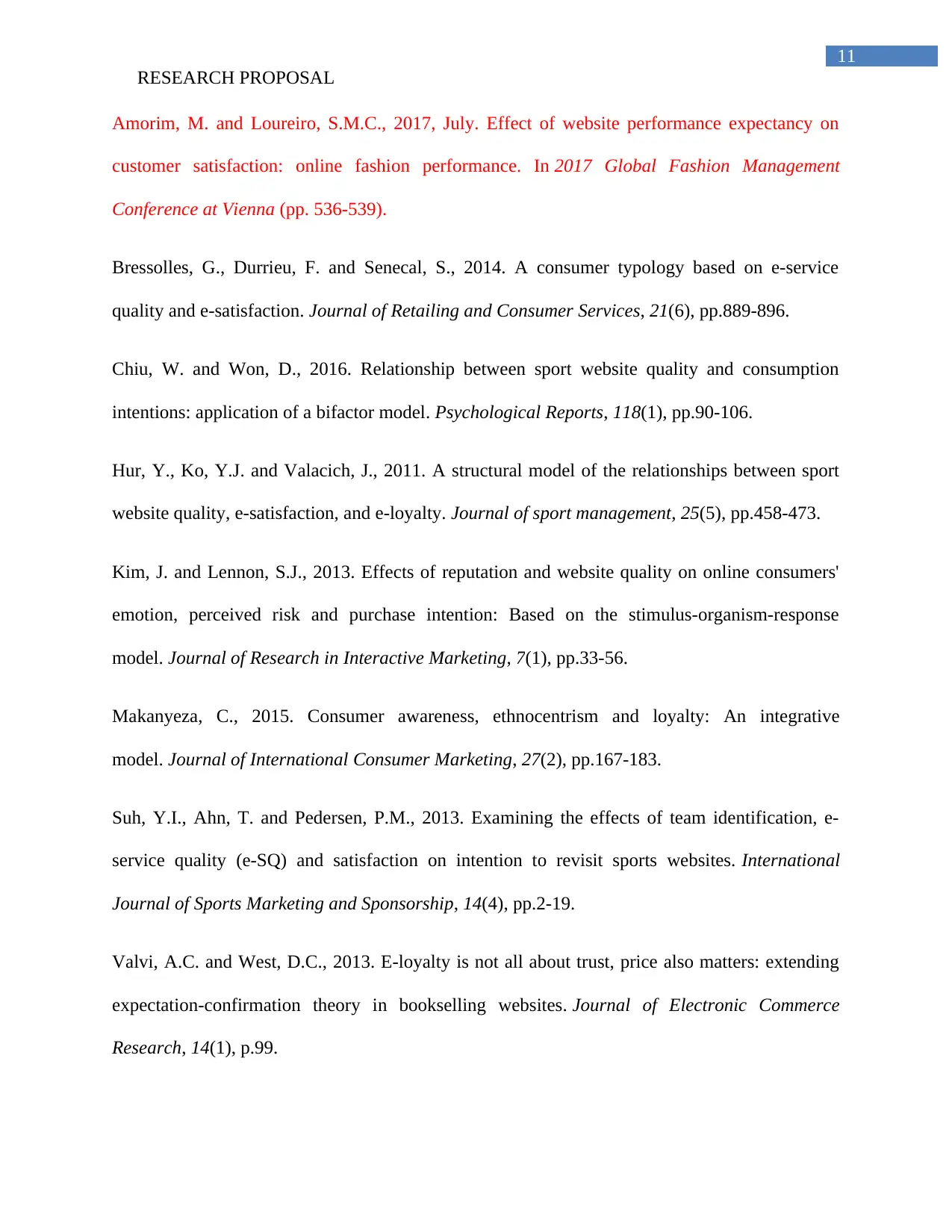
11
RESEARCH PROPOSAL
Amorim, M. and Loureiro, S.M.C., 2017, July. Effect of website performance expectancy on
customer satisfaction: online fashion performance. In 2017 Global Fashion Management
Conference at Vienna (pp. 536-539).
Bressolles, G., Durrieu, F. and Senecal, S., 2014. A consumer typology based on e-service
quality and e-satisfaction. Journal of Retailing and Consumer Services, 21(6), pp.889-896.
Chiu, W. and Won, D., 2016. Relationship between sport website quality and consumption
intentions: application of a bifactor model. Psychological Reports, 118(1), pp.90-106.
Hur, Y., Ko, Y.J. and Valacich, J., 2011. A structural model of the relationships between sport
website quality, e-satisfaction, and e-loyalty. Journal of sport management, 25(5), pp.458-473.
Kim, J. and Lennon, S.J., 2013. Effects of reputation and website quality on online consumers'
emotion, perceived risk and purchase intention: Based on the stimulus-organism-response
model. Journal of Research in Interactive Marketing, 7(1), pp.33-56.
Makanyeza, C., 2015. Consumer awareness, ethnocentrism and loyalty: An integrative
model. Journal of International Consumer Marketing, 27(2), pp.167-183.
Suh, Y.I., Ahn, T. and Pedersen, P.M., 2013. Examining the effects of team identification, e-
service quality (e-SQ) and satisfaction on intention to revisit sports websites. International
Journal of Sports Marketing and Sponsorship, 14(4), pp.2-19.
Valvi, A.C. and West, D.C., 2013. E-loyalty is not all about trust, price also matters: extending
expectation-confirmation theory in bookselling websites. Journal of Electronic Commerce
Research, 14(1), p.99.
RESEARCH PROPOSAL
Amorim, M. and Loureiro, S.M.C., 2017, July. Effect of website performance expectancy on
customer satisfaction: online fashion performance. In 2017 Global Fashion Management
Conference at Vienna (pp. 536-539).
Bressolles, G., Durrieu, F. and Senecal, S., 2014. A consumer typology based on e-service
quality and e-satisfaction. Journal of Retailing and Consumer Services, 21(6), pp.889-896.
Chiu, W. and Won, D., 2016. Relationship between sport website quality and consumption
intentions: application of a bifactor model. Psychological Reports, 118(1), pp.90-106.
Hur, Y., Ko, Y.J. and Valacich, J., 2011. A structural model of the relationships between sport
website quality, e-satisfaction, and e-loyalty. Journal of sport management, 25(5), pp.458-473.
Kim, J. and Lennon, S.J., 2013. Effects of reputation and website quality on online consumers'
emotion, perceived risk and purchase intention: Based on the stimulus-organism-response
model. Journal of Research in Interactive Marketing, 7(1), pp.33-56.
Makanyeza, C., 2015. Consumer awareness, ethnocentrism and loyalty: An integrative
model. Journal of International Consumer Marketing, 27(2), pp.167-183.
Suh, Y.I., Ahn, T. and Pedersen, P.M., 2013. Examining the effects of team identification, e-
service quality (e-SQ) and satisfaction on intention to revisit sports websites. International
Journal of Sports Marketing and Sponsorship, 14(4), pp.2-19.
Valvi, A.C. and West, D.C., 2013. E-loyalty is not all about trust, price also matters: extending
expectation-confirmation theory in bookselling websites. Journal of Electronic Commerce
Research, 14(1), p.99.
⊘ This is a preview!⊘
Do you want full access?
Subscribe today to unlock all pages.

Trusted by 1+ million students worldwide
1 out of 13
Related Documents
Your All-in-One AI-Powered Toolkit for Academic Success.
+13062052269
info@desklib.com
Available 24*7 on WhatsApp / Email
![[object Object]](/_next/static/media/star-bottom.7253800d.svg)
Unlock your academic potential
Copyright © 2020–2025 A2Z Services. All Rights Reserved. Developed and managed by ZUCOL.





